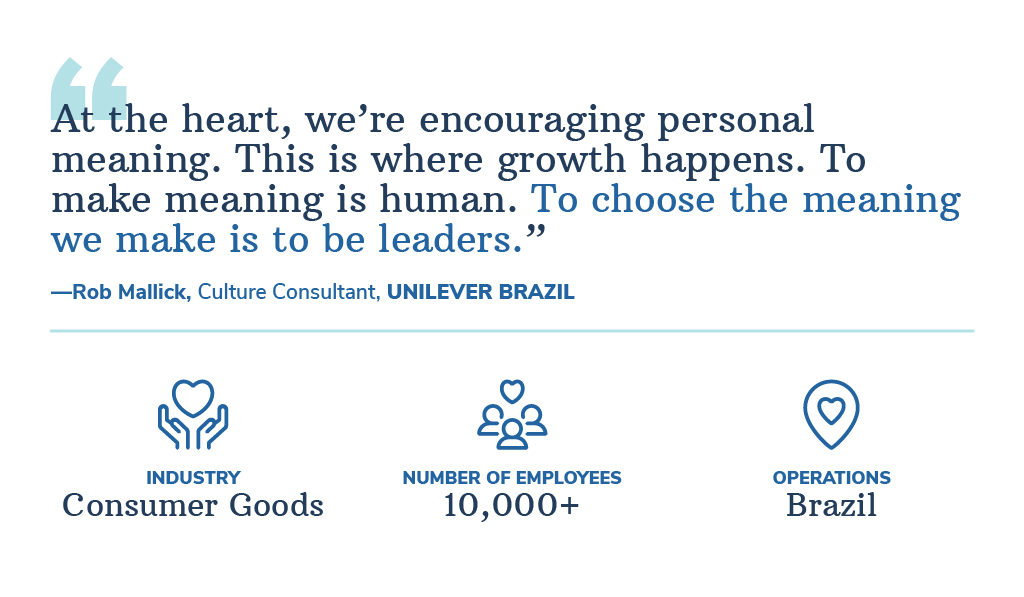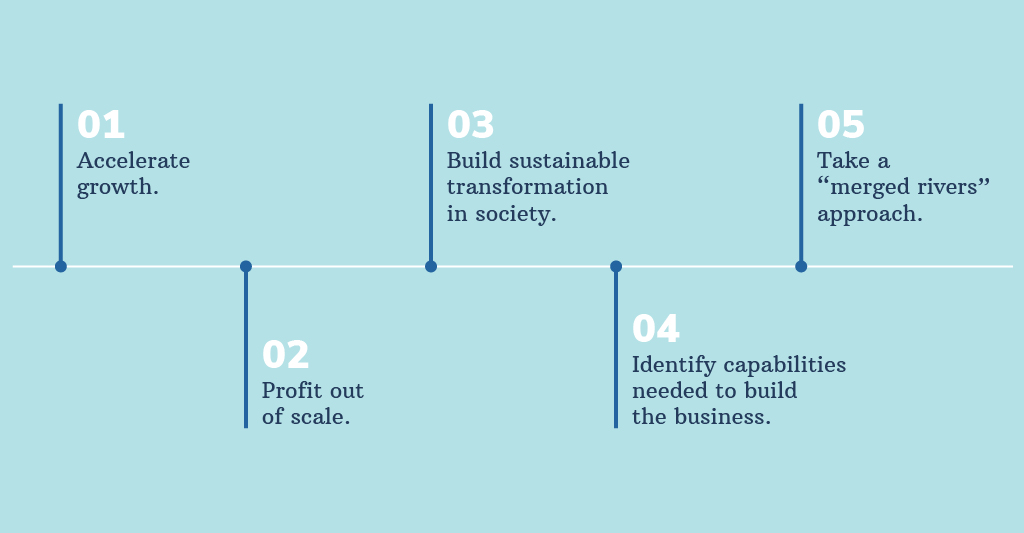In the following cultural change in organizations example, you will learn more about the concept of the culture change journey. It’s important to recognize that every organization whose leadership chooses to embark on such a journey has different intentions and approaches toward cultural transformation. There is not just one way but many ways to successfully work with your culture.

Unilever Brazil had an incredible legacy built over 80 years; however, in 2004–05, after decades of strong growth, revenues slowed and the business needed renewal.
In early 2008, Kees Kruythoff, the newly appointed chairman, along with the Unilever Brazil board, launched a transformational effort to reignite growth.
They recognized a need not only to address strategic challenges and manage operations but also to address the organizational culture. They had five big thoughts:

THE PROCESS
Unilever Brazil developed a shared understanding among senior leadership that the concept of a linear process can be outdated and ineffective. Truly dynamic work with culture change is very much in the moment and allows for human dynamics.
The company conducted a Cultural Values Assessment every six months for the duration of the culture change journey.
Disciplined attention was maintained for 36 months. The company emphasized that leaders create culture, and it encouraged board members to reflect on their personal values and the culture they desired to create at Unilever Brazil. The board led the executive team through the same process. Then the executive team led all 250 managers through the process as well.
The company established rituals and meaning, (i.e., regular, consistent practices and time for reflection on key espoused values).
Needs were continually reframed (e.g., when there was an overemphasis on safety, company leaders taught the need for risk taking and vulnerability).
THE OUTCOME
Revenue grew by 3% in 2008, 7% in 2009, and into the double digits by the second quarter of 2010. Revenue growth was also driven by increases in market share, not price.
Entropy, the degree of unproductive focus, fell from 37% to 19% and then to 10% in 2010. Entropy in the top team fell from 31% to 8%.
Instead of a culture characterized by caution, short-term focus, internal competition, and consensus, employees now experience a business with long-term perspective, shared vision, teamwork, and a strong orientation toward customer satisfaction and the development of leaders.
![]()
 In 2017, Ashley Munday, Former Director of Thrive by SweetRush, and Tor Eneroth, Director of Cultural Transformation at Barrett Values Centre, wrote an eBook as a resource and workbook for leaders to get started on the culture journey in a meaningful and tactical way. To accommodate as many leaders as possible, we have converted the content into a series of articles that can be read piece by piece and will be publishing them on a weekly basis. We invite you to consume the material at your own pace and welcome your feedback and questions along the way. Thrive by SweetRush is now known as Transforming Leaders and Culture (TLC) by SweetRush. Please reach out to begin transforming your organization today!
In 2017, Ashley Munday, Former Director of Thrive by SweetRush, and Tor Eneroth, Director of Cultural Transformation at Barrett Values Centre, wrote an eBook as a resource and workbook for leaders to get started on the culture journey in a meaningful and tactical way. To accommodate as many leaders as possible, we have converted the content into a series of articles that can be read piece by piece and will be publishing them on a weekly basis. We invite you to consume the material at your own pace and welcome your feedback and questions along the way. Thrive by SweetRush is now known as Transforming Leaders and Culture (TLC) by SweetRush. Please reach out to begin transforming your organization today!
![]()
If you’re reading this series, we know you are a leader who understands and cares about the way your organization’s culture supports its people and its purpose—for that, we thank you! Check out the other articles in this series:
- Culture Change in Organizations Begins Within
- Organizational Culture Transformation—A Journey, Not a Destination
- Culture Change Case Study: Volvo IT
- Changing Corporate Culture Case Study: Old Mutual Group
- Cultural Change In Organizations Example: Unilever Brazil
- Key Learnings in Culture Transformation
- Growing Your Desired Culture: Leadership Commitment
- Growing Your Desired Culture: Roles for Supporting Culture
- Growing Your Desired Culture: Defining and Growing Your Culture
- Growing Your Desired Culture: Structural Alignment
- Growing Your Desired Culture: Follow-Up and Learning




